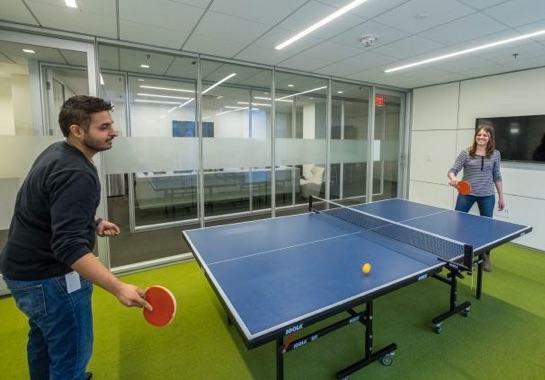
Isaac Newton was a hack.
I know that will ruffle some feathers among our readers in the physics community (of whom there are many). But I had to get your attention.
Newton was lucky enough to have a great idea fall onto his head. Unless you have apple trees growing in your conference room—don’t underestimate SaaS companies—that’s not going to happen during your next marketing team meeting.
We like to play ping-pong.
Instead, you’ll have to do some brainstorming. The ubiquity of that term may lead you to assume that it’s an easy exercise. Don’t be fooled.
Done right, brainstorming is productive and fun. Done wrong, it’s a complete waste of time.
To take your marketing team meetings to the next level, use these seven brainstorming techniques.
A brief overview of brainstorming
The brainstorming process was popularized in the 1950s by Alex Osborn, an advertising executive at Barton, Batton, Durstine, & Osborn (BBDO).
Frustrated by his employees’ inability to come up with good campaign ideas on their own, Osborn started to experiment with different collaborative exercises. Eventually, he settled on a model grounded by four simple principles:
-
Generate as many ideas as possible. For the purposes of this exercise, quantity is more important than quality.
-
Don’t judge any ideas until the session is over. People will hold back if they think they may be judged negatively.
-
Encourage people to think outside of the box. Although wild ideas may not be feasible, they steer the conversation in new directions.
-
Combine ideas. Encouraging people to build off one another makes it easier for them to contribute and boosts team morale.
Osborn developed his model with straightforward tasks in mind—naming a new product or feature, creating a slogan, deciding on the emotional tone of a new campaign, and so on. More analytical projects that require deep, critical thinking aren’t well-suited for his method.
Homer would have had a spot on Osborn’s team.
In short, you can think of brainstorming as collaborative spitballing: participants are uninhibited by fear of judgement and are encouraged to offer whatever comes to mind in the moment.
7 Essential Brainstorming Techniques
Whether you’re introducing brainstorming to your marketing team meetings for the first time or looking for ways to refresh your ideation sessions, don’t expect it to go off without a hitch. It’s going to be a process of trial and error. Plus, every team is unique—there is no one-size-fits-all solution.
Mix and match these techniques and eventually you’ll find the perfect brainstorming cocktail.
1. Work alone—together
According to Art Markman, a professor of psychology and marketing at UT Austin, a potential consequence of brainstorming is convergent thinking: the tendency for individuals’ ideas to become increasingly similar over the course of a brainstorming session.
Markman suggests giving people time to think by themselves prior to the brainstorm. That way, everyone has a chance to take his or her thought process in a unique direction. A room full of confident people with slightly different perspectives on the issue at hand has tons of potential.
2. Assemble a team of people who really know each other
Back in 2015, researchers at the Creative Education Foundation found that a brainstorming session is far more effective—and in line with Osborn’s findings—when the participants are familiar with each other.
Many studies that claim to undermine the legitimacy of Osborn’s model use groups of complete strangers. It’s apparent that the problem is not Osborn’s framework, but the participants’ lack of comfort with one another.
Familiarity is key.
For the best results, put together a group of employees who are not only capable of working together, but who enjoy working together, too.
3. Brainstorm questions, not answers
Sometimes your brainstorming session hits a dead end. The participants, though intelligent and close-knit, are simply uninspired.
When he encountered this problem with his MBA students, Hal Gregersen, senior lecturer at the MIT Sloan School of Management, threw a hail mary: he asked his students, who had been brainstorming solutions to the problem of gender parity in the workplace, to start spitballing questions that framed the issue in a fresh way.
Gregersen in action. Via YouTube.
It worked. Gregersen’s heat-of-the-moment curveball reinvigorated the classroom and pushed his students to generate novel perspectives on the matter. Soon, the brainstorm reached a peak level of productivity.
The success of the experiment encouraged Gregersen to develop a full brainstorming model, and at the core of it is this: when everybody is sitting around and waiting for a eureka moment, becoming increasingly discouraged by the minute, asking them to brainstorm questions gives them a confidence-boosting sense of control and steers the session into a direction you never would have found otherwise.
4. Don’t forget about the afterparty
Remember: the point of brainstorming is to generate as many ideas as possible within the time constraints. There should be no discussion or criticism during the session.
The benefit of this model is that it fosters a lot of enthusiastic participation. The downside is that it leaves no room for fleshing out individual ideas.
That’s what the afterparty—formally known as convergence—is for. After all, the laundry list of ideas you’ve assembled is pretty worthless until you turn those sketches into masterpieces.
There are two ways you can go about this: attention guidance or discussion encouragement. Last year, a team of researchers looked into the effectiveness of both approaches.
The purpose of attention guidance is to bring the participants back together and direct their attention toward a specific task. Whether that task is filling out a particular idea or drawing commonalities across all ideas, the point is that the leader of the group controls where the conversation goes.
Some structure can go a long way. Via VideoBlocks.
Discussion encouragement, on other hand, is far less structured. Basically, the participants sit down with the list of ideas from the brainstorm and discuss them further. They have the freedom to decide what gets expanded upon and what direction the conversation goes in.
Whereas attention guidance helps everyone process the information at a deeper level, discussion encouragement helps clarify and synthesize specific ideas.
Regardless of which approach you employ, it’s crucial that you give team members an opportunity to keep the party going.
5. Differentiate between feasible and original
As with any team-based activity, it’s important to clearly define the goals of your brainstorming session. Are you looking for ideas that can be seamlessly implemented in your current marketing scheme, or are you looking for some truly off-the-wall material?
According to Brian Johnson and Chris D’Lauro over at the Air Force Academy, this decision is a pretty big one.
Why? Because when people are instructed to pick the single best idea, they tend to pick a feasible, unoriginal concept that was generated early in the brainstorming session.
However, when people are instructed to pick the most feasible idea and the most original idea, they tend to pick one that was generated early and one that was generated late, respectively.
In other words, as a brainstorming session goes on, the ideas tend to get less feasible and more original.
So if you’re looking for something that falls in line with what you’re already doing, you can keep your sessions short and sweet. And if you’re looking for something that you’ve never done before, you should aim for relatively long brainstorms.
This is crucial. If you’re unclear about your goals as a team, you may waste time and energy running with ideas that are totally misaligned with what you’re trying to accomplish.
6. Change the scenery
One of Osborn’s key insights was that timidity and fear are the worst enemies of the brainstorm leader. That’s why you’re supposed to withhold criticism, right?
Well, even if you successfully postpone judgement, you may still find that some participants are hesitant to chime in. Kathleen Lucente of Red Fan Communications (a PR agency) says you can blame the familiarity of your conference room.
Lucente finds that working with the same people in the same workspace often yields complacency. By contrast, if you bring your brainstormers somewhere new, the stimulation of a fresh environment may provide the cognitive boost everyone needs to come up with truly exciting ideas.
Show me the science that says beer doesn’t improve marketing campaigns. Via CBS Denver.
If you’re near a fun restaurant that everyone likes, conduct your brainstorming session over lunch. Alternatively, if it’s a group that likes to party, head out of the office a little before 5:00 and do it with drinks. As long as you can keep everyone on track for the duration of the session—which need not be long if you’re looking for ideas that are simply feasible—the change of scenery can work wonders.
7. Introduce a fresh perspective
Admittedly, for this last suggestion, I’m taking some liberties with Lucente’s insights.
If a new environment can jolt a brainstorming session into high gear, I think it follows that bringing in some people who aren’t part of your marketing team can have the same effect.
This ties back to the concept of convergent thinking that I mentioned under the first technique. You don’t want everyone’s ideas to bleed into each other because this convergence effectively narrows the scope of the session—and that’s the polar opposite of what you want.
Bring in some of your coworkers from other parts of the company. It’s likely that their backgrounds in sales, customer support, and other areas will breed unique viewpoints that direct your session into uncharted territory.
Bringing it all together
By this point, I’m confident that you’ve picked up on the same theme that I noticed while I was doing research for this blog post.
The key to a productive brainstorming session is stimulation. And the key to stimulation is changing things up. Think about it: what’s less mentally stimulating than routine?
Good news: there’s no shortage of ways you can change it up. Whether you allow brainstormers to initially think by themselves, challenge them to think of questions rather than answers, or invite them to throw back some Bud Lights, what matters is that you break their routines just enough to bring out the brilliance you know is inside their heads.
It goes without saying that the list I’ve compiled here is far from exhaustive. I have no doubt that you can double its length in an hour simply by dreaming up new ways to get people excited about your marketing team meetings.
In fact, let’s get meta: get the team together and brainstorm some new ways to brainstorm. The possibilities are endless!












